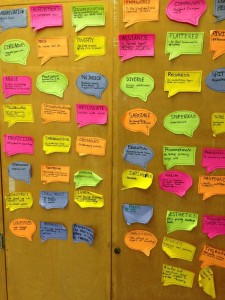“Did I get it right teacher, did I get it right?”. This I am sure you have heard over and over again when it is time for students to take up their work. I can go back to my elementary school years (way too long ago to provide a date for you) and remembering sitting there anticipating getting my paper back so that I could look at the top of the page and see my grade. Red on your paper was not a good thing. Either a smile or a sad expression immediately came across my face and I would be asked to get it signed by my parents, return it to my teacher and move on to my next unit of study.
Good assessment pedagogy now has taught us that the opportunity for learning is in examining the mistakes, looking at what strategies were being used and providing timely feedback that allows a student to learn from their own work. This approach helps facilitate their growth toward those target outcomes.
I have an anchor chart in my room that is used by both my students and by myself when we are looking at the work we have completed. On that chart are three defined types of mistakes that can be made. The first is referred to as ‘Careless Mistakes’ which are characterized by minor mistakes that are made as a result of miscalculations, rushing through work or more typically a student not looking back and checking their work prior to handling it in. When I am conferencing with a student about their work and find these types of mistakes it indicates to me that the student has grasped the key concepts and need feedback/strategies on how to avoid making those types of errors.
The second type of mistake that can be made are ‘Misconceptions’. These are characterized by a student’s understanding of a concept being inaccurate and thus as the student moves forward with his/her thinking, that student is immediately going down a wrong thinking pass that will result in his/her work being wrong. This will lead me to create a mini lesson for that student or a group of students that will help adjust their thinking by clarifying the necessary content to eliminate the misconception(s).
The final type of error is due to a ‘Lack of Knowledge’. In this scenario the student does not have the necessary background knowledge or sub-skills in order to accomplish the task at hand. This immediately indicates the need for me to assess where the student knowledge base lies and backtrack to that point in order to provide him/her with the necessary next step in his/her learning. I find this often is below grade level and thus requires me to modify the content to help that individual gain the necessary knowledge to move his/her learning forward. This scenario occurred just last week in my class as we moved into a unit on fractions. In my diagnostic task it became very clear to me that my students had little or no understanding of what fractions were despite being comfortable with using the word fraction. They could take an apple and split it into two pieces, describe each piece as a half but not quantify what that meant.
By sharing this understanding with my students, it facilitates their participation and role in the learning process. They now have more ownership over their work, over their effort and over their plan on moving forward with their own learning.

 all home and tell their parents about some positive scenario that took place that day. They 100% of the time say an astounding yes. As they come to realize this is a regular part of our classroom, they begin to ask me to call their family and let them know about their math work or reading. That is the time that I know why I will always look to see the glass as half full.
all home and tell their parents about some positive scenario that took place that day. They 100% of the time say an astounding yes. As they come to realize this is a regular part of our classroom, they begin to ask me to call their family and let them know about their math work or reading. That is the time that I know why I will always look to see the glass as half full.

